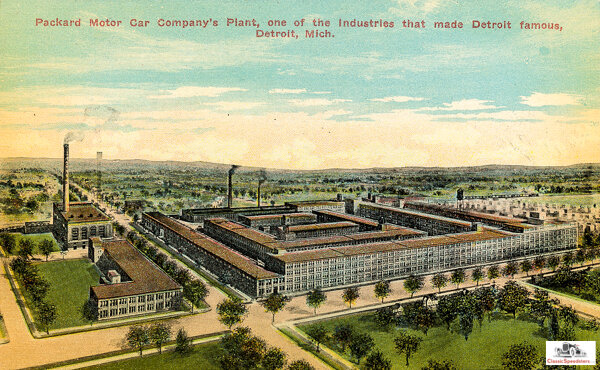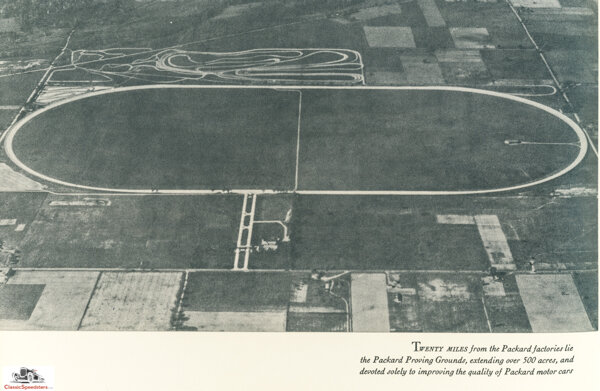Backing In
It wasn’t like the Packard brothers were itching to build a car in 1898. After all, they already had a successful electrical business in Warren, Ohio. It’s just that their 1898 Winton wouldn’t stay running, and when they suggested some improvements that could be made to make it run better, they were soundly rebuffed by none other than Alexander Winton himself. Or so the story goes…
Told by the haughty Winton that they should go build their own car if they were so smart, well – that is just what they did!
The Winton was a brand-new product in 1898, a true horseless carriage, or rather, a buggy, and only 21 were made that season. James Ward Packard had bought one. Inevitably it would have bugs to work out. And, of course, the Packard brothers, entrepreneurs that they were, soon geeked out on this new venture of horseless carriages.
The Packard brothers, William Doud (left) and James Ward (right) as seen in company portraits.
James Ward and his brother William Doud had formed Packard Electric Company in 1890 to make carbon arc lamps. They partnered with George E. Weiss in 1893, who was also a backer of Winton, which is how the Packards came to own a Winton.
By 1899 the Packards had built their first car and soon after founded a car company with Weiss’ help, and before long their cars attracted other investors who knew a good thing when they saw one. The company name became Packard Motor Car Company in 1902.
Stepping Up
In the first decade of the new century, entrepreneurs in almost every city were making a horseless contrivance of one sort or another – a motorbike, a tricycle, or a four-wheeled automobile. At this point in time, small meant cheap, while large meant luxurious.
1899 Packard model #1. Note its tiller steering and resemblance to a horse-driven buggy. Typical of Packard, this example nevertheless looks sturdy and well-engineered! factory photo courtesy of AACA library
Packard early on established itself as a luxury brand. Although initially compact in size, Packard soon produced cars that were large and luxurious, but they were also well-engineered and dependable. The group of investors who bought into the fledgling corporation also had the foresight to strategically move Packard to Detroit, which would become the center of American automotive manufacturing. Then they hired the best-known industrial building architect, Albert Kahn, and he built the biggest and best factory possible at that time. All of this laid the foundation for Packard’s growth.
Packard plant in 1911. The building at left was first constructed in 1903, after which the plant expanded and was built out as it stretched to a mile in length by the 1930s! Postcard image courtesy Skillman Automotive Collection, Detroit Public Library
Its reputation as a premier luxury automobile, preferred by bluebloods, captains of industry, leaders of nations, and the stars of Hollywood, would stand unblemished for decades.
Venturing Forth
Big money and big plans are nothing without talent and innovation. Packard had talent in spades in its board of directors, who in turn hired a gifted set of engineers and managers to create generations of Packards that spoke money while also featuring the latest in automotive technology. Some of Packard’s notable accomplishments:
• first car to use a steering wheel (1904),
• made the first production 12-cylinder engine (1916), • successfully produced the renowned Liberty L-12 engine for the Curtiss JN-4 “Jenny” and other aircraft in WWI (1918)
• Ride Control, an in-car shock adjustment system
• produced the 12-cylinder 4M-2500 powerplants for the PT boats during WWII
• reworked and perfected the British 12-cylinder Merlin to make the Packard-Merlin V-1650-7, a supercharged 1500 horsepower monster that powered the North American P-51D.
Oh, and: Packard was also first in air conditioning for cars!
Rising to the Challenge
James A Macauley was the President of Packard through many of its most successful years. MacAucley had hired Jesse Vincent in 1915, a gifted mechanical engineer who had speedsterism in his blood. Vincent would design several performance engines and other new technologies for Packard.
Jesse Vincent at his desk at Packard, c. 1935 Packard company portrait
Under his leadership, Macauley directed Albert Kahn in 1926 to design the Packard Proving Grounds, a 2.5 mile test track and compound that was situated north of Detroit. In later years, this would become Vincent’s stomping grounds and home for Vincent’s speedsters.
The Packard Proving Grounds in 1933, as seen from this company aerial photo. Adjoining the 2.5 mile oval, which is the same size as the Indianapolis 500 track, are a collection of administrative buildings and garages on the site. Note the winding, hilly test roads seen at the top of the photo.
Vincent was responsible for Packard’s first series of 12-cylinder cars, known as the Twin Six series, in 1916. Later, while being commissioned as a major in the U.S. Army, Vincent collaborated with Elbert Hall of Hall-Scott Motor Company to design and develop the Liberty V-12 engine that was used in WWI by the U.S. Army Air Corps.
1916 Packard Twin-Six. Ad courtesy AACA Liabrary
After the Great War ended in 1918, surplus Liberty engines were sold off and put to use in high speed powerboats, and Vincent, a speed enthusiast, would inevitably compete in powerboat racing. Vincent won the 1922 Gold Cup on the Detroit River in a Chris Smith-designed boat, beating five-time winner and renowned boat designer Gar Wood. Vincent had used twin Packard Liberty V-12s in his Packard-Criscraft to beat the Wood-designed Miss America II, which was also running a pair of Packards. This win no doubt inspired boat builder Chris Smith to separate from Wood and strike out on his own, renaming his company in 1924 as Chris-Craft!
Garfield “Gar” Wood c. 1920 photo courtesy Library of Congress
Beaten but not conquered, Gar Wood would continue producing stellar speed and pleasure boats well into the 1940s, winning trophies and burnishing his reputation as the premier designer of American power boats.
This photo appeared in a 1940 Packard ad to note that Gar Wood’s Miss America X, with four Packard Liberty engines, had once again broken the unlimited powerboat-class speed record. Ad courtesy AACA Library
Not surprisingly, Gar Wood also designed a line of 16-foot twin-cockpit runabouts in 1934 for pleasure use and racing competitions on the St. Lawrence River. Inspired by a similar sporting craze that had dominated automobiles for over thirty years, Wood called them Gar Wood Speedsters! Edward Noble, founder of Lifesavers candy, bought one and named it Miss Behave…
Forging Ahead
1930 Packard ad. Note the image in the ad makes a direct appeal to the affectations of upper-crust society. Ad courtesy AACA Library
As a luxury automobile company, Packard’s cars catered to the ballroom and county club set. Although enterprising racers would use its engines in specials that won events on both road and river, and would perform daring aerial maneuvers in Packard-powered aircraft both in war and in peace-time, Packard itself shunned racing and performance-oriented events. Instead, Packard focused on its upper crust clientele and their leisure lifestyle. …while also putting up ads that touted its success in building high-performance engines for others to use!
1927 “Master Motor Builders” ad. Ad courtesy AACA Library
Jesse Vincent, however, was a racer at heart, and as chief engineer he also had the run of the Packard Proving Grounds, which had opened in 1928. Several of his creations were made to go fast, and Vincent designed a variety of Packard prototype speedsters that would test new components which insinuated themselves into sporting models as well as production speedsters for Packard.
1928 Vincent Packard Speedster at the Packard Proving Grounds. Although there were a few variations, this was the basic package that led to successive generations of production Packard speedsters as seen in the Series 626, 734, and 1106 Packards. photo courtesy William Bailey collection
Ironically, not one of these performance-oriented Packard speedsters would ever persist past a small production run or a season. Rather, they were manufactured in limited numbers, barely advertised, and did not connect to any of the Packard-powered track and road racing that was carried on by privateers.
1930 Packard 734 Boattail Speedster, seen here at the administrative lodge of the Packard Proving Grounds. The 734 Speedster series came in Coupe, Convertible Coupe, Phaeton, and in Boattail form. Packard factory photo
Packard would weather a variety of recessions, persevere past the Great Depression of 1930-33, thrive during two world wars, and maintain a steady course as the premier independent luxury brand well into the 1950s. During its tenure, Packard was able to hang its emblem on close to 1,000,000 examples of fine motor vehicles.
And, along the way, it managed to produce a few classic examples of speedsters that stand tall in classic car circles to this day.
All in all, the company slogan summed up the Packard experience: Just ask the man who owns one!
For more details about the Packard Speedsters, please read my article about them, entitled “The Rise and the Demise of the Packard Speedsters”, which was published in Antique Automobile magazine, V83, N1, Jan/Feb 2019.
Download a copy of the article here. [Open it in Adobe Acrobat and view the article in side-by-side configuration for best results in viewing the photos.]
Antique Automobile magazine, Jan/Feb 2019. Cover image is of a 1934 Packard Series 1103 Twelve Sport Speedster Image courtesy West Peterson collection
The article itself is an excerpt from my book, Classic Speedsters: The Cars, The Times, and The Characters Who Drove Them, publishing date TBA. I’ll keep everyone informed with news on the book that I will post here on my blog site as well as on my website, ClassicSpeedsters.com. I appreciate your interest and support!
If this is your first visit to this site, or if you have not yet signed up to receive news of new posts, please subscribe using the box to the right. You may have to scroll up a bit! to locate the box! >>>>>
And if you know of someone in your group who would like to read this journal, please forward this website’s address to them. You can also share this site and post using the social media links icon on the left side of this screen. Let’s share the love of speedsters! <<<<<














